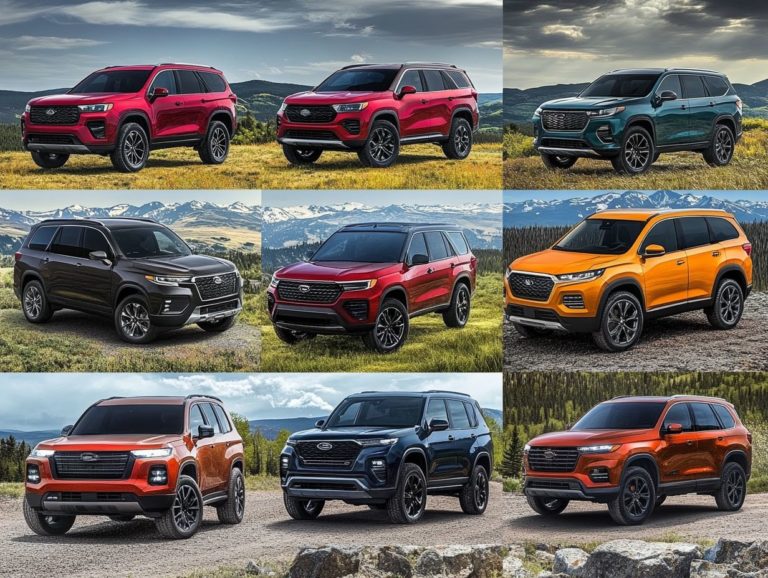User Experiences: Affordable Cars with Safety Ratings
When choosing a car, safety and affordability likely sit at the forefront of your concerns. With a myriad of options available, it becomes essential to identify which vehicles align with your budget while boasting high safety ratings.
This article delves into the criteria that shape these ratings, showcases top affordable cars that shine in the safety department, and emphasizes the significance of crash test results.
Explore with us as we reveal tips for discovering the ideal balance between safety and value in your next vehicle.
Contents
- Key Takeaways:
- 1. Top Affordable Cars with High Safety Ratings
- 2. The Importance of Safety Ratings When Choosing a Car
- 3. Affordable Cars with the Best Crash Test Results
- 4. Tips for Finding the Best Affordable and Safe Car for Your Needs
- 3. Affordable Cars with the Best Crash Test Results
- What Are the Top Affordable Cars with the Best Crash Test Results?
- How Can a Car’s Size and Weight Affect Its Safety Rating?
- Tips for Finding the Best Affordable and Safe Car for Your Needs
- Frequently Asked Questions
- What are some factors to consider when choosing an affordable car with good safety ratings?
- Can a car be both affordable and safe?
- How do I find information on a car’s safety ratings?
- What are some common safety features to look for in an affordable car?
- Is it worth paying extra for a car with higher safety ratings?
- Can I test drive a car to experience its safety features?
Key Takeaways:

- Affordable cars can also have high safety ratings, making them a good option for those on a budget.
- Safety ratings should be a top priority when choosing a car as they can impact insurance rates and provide peace of mind.
- Crash tests and safety features are important factors to consider when evaluating a car’s safety rating.
1. Top Affordable Cars with High Safety Ratings
When selecting the best affordable cars for teen drivers or families, prioritizing high safety ratings is essential. This focus on safety brings peace of mind as you navigate the roads, especially considering that inexperienced drivers are often more susceptible to accidents.
Organizations like the IIHS and NHTSA conduct rigorous simulations and real-world crash tests, making their ratings invaluable indicators of a vehicle s crashworthiness, which means how well a vehicle protects its occupants in an accident. Among the standout models, the Toyota Corolla, Honda Civic, and Subaru Impreza not only excel in safety assessments but also provide long-term reliable performance, making them top choices for families.
These safety ratings are pivotal in your decision-making process, particularly if you’re seeking vehicles for your teen drivers who may require that extra layer of protection. Strong reliability scores provide reassurance that you re making a wise investment not just regarding safety, but also in terms of maintenance costs and the longevity of the vehicle.
2. The Importance of Safety Ratings When Choosing a Car
Understanding safety ratings is essential when you’re in the market for a car, especially if you have a family or a teen driver. These ratings significantly impact both the overall safety of the vehicle and the insurance costs.
When selecting a vehicle, it s crucial to realize that comprehensive safety ratings can influence not just how well the car performs in crash tests, but also the financial implications tied to insuring it. For young drivers, often seen as higher-risk, opting for a vehicle with excellent safety ratings can result in lower car insurance premiums.
Features like lane departure warning and adaptive cruise control are increasingly highlighted in consumer reports as key components for enhancing road safety. By choosing cars that come equipped with these technologies, you can feel more at ease about your child’s safety on the road, making the review of safety ratings a critical practice in your car-buying journey.
3. Affordable Cars with the Best Crash Test Results
For those in search of affordable cars that deliver impressive crash test results, it’s crucial to grasp the ratings from organizations like IIHS and NHTSA. These insights help you pinpoint vehicles that balance safety and value. Additionally, considering user ratings for the best cars for teen drivers can further guide your choices. Models such as the Toyota RAV4, Honda Accord, and Hyundai Tucson have all excelled in crashworthiness tests, making them standout options for anyone prioritizing safety without breaking the bank.
These ratings reveal how well a vehicle can shield its occupants during a collision, guiding you toward the safest choices on the market.
Don t wait! The IIHS has bestowed top safety picks upon these models, underscoring their remarkable crash performance and sophisticated safety features. Take the Toyota RAV4, for instance; it garnered high scores for both front and side impact tests. The Honda Accord shines with its robust structure designed to minimize injury risk. Meanwhile, the Hyundai Tucson not only aced these evaluations but also boasts impressive reliability scores, presenting an ideal choice for long-term ownership.
Reliability ratings add an extra layer of reassurance, indicating how a vehicle performs over the years. This ensures that safety isn t just a fleeting concern but a lasting attribute of your automotive selection.
4. Tips for Finding the Best Affordable and Safe Car for Your Needs
Finding the best affordable and safe car that suits your unique needs demands thoughtful consideration, especially when it comes to families and teen drivers.
Beyond safety ratings, it s crucial to delve into the vehicle’s history with detailed checks. These inspections should be meticulous, enabling you to identify any potential red flags, such as rust, suspension problems, or unusual noises.
Look for user-friendly technology that makes driving safer and more enjoyable. Features that enhance safety, convenience, and driving comfort are essential. Consumer reports can be your best friend here, offering valuable insights that shed light on real-world performance and owner satisfaction.
Striking the perfect balance between affordability and safety requires wise investment. This ensures that your choice not only aligns with your budget but also provides the peace of mind you deserve for your loved ones on the road.
What Are the Criteria for High Safety Ratings?
High safety ratings are determined by a blend of rigorous crashworthiness tests and performance evaluations conducted by agencies such as the IIHS and NHTSA. These assessments focus on various critical aspects of vehicle safety, particularly for protecting occupants like teen drivers. You’ll find these criteria include evaluations of strength of the vehicle and occupant protection in crashes, along with advanced safety features like automatic emergency braking.
These organizations use a thorough method, incorporating crash tests from multiple angles and simulations that replicate realistic driving scenarios. Features like automatic emergency braking are crucial; this technology can prevent accidents by automatically applying the brakes when a potential collision is detected.
Such advancements not only provide a safety net for inexperienced teen drivers but also instill a sense of confidence in parents as they consider vehicles for their children. As safety remains a paramount concern, grasping the standards set by these agencies gives you the power to choose cars that seamlessly blend safety with value.
How Are Safety Ratings Determined?

Safety ratings are derived from thorough crashworthiness tests and evaluations carried out by esteemed organizations like the IIHS and NHTSA. These agencies meticulously analyze a vehicle’s capability to safeguard its occupants across various collision scenarios. Their tests involve real-world crash simulations, where they collect critical data on the performance of essential safety features and the vehicle’s overall structural integrity.
By employing standardized testing methods and factoring in elements such as reliability scores and vehicle identification numbers, these organizations provide you with critical information to make informed purchasing decisions.
The IIHS conducts a variety of crash tests think front moderate overlap evaluations, side impact tests, and assessments for rear crash protection while the NHTSA uses simulations that involve frontal and side crashes at different speeds. Through these rigorous evaluations, both organizations compile extensive data on a vehicle’s behavior during collisions, analyzing key aspects like airbag deployment, seatbelt effectiveness, and potential injury risks to occupants.
The importance of vehicle identification numbers cannot be overstated; they grant you access to specific safety ratings and recall information, giving you the power to make well-informed choices when selecting a vehicle that meets your safety requirements. Choosing a car that meets your safety requirements is not just important; it’s essential for your peace of mind on the road.
What Are the Top Affordable Cars with High Safety Ratings?
Some of the top affordable cars with high safety ratings include celebrated models like the Toyota Corolla, Honda Civic, and Subaru Impreza. For more insights, check out user reviews on the safest cars of 2023. These vehicles consistently receive accolades from both the Insurance Institute for Highway Safety (IIHS) and the National Highway Traffic Safety Administration (NHTSA) for their exceptional safety performance.
They excel in tests that measure how safe a car is during accidents. Additionally, they come equipped with features that enhance overall safety, making them ideal choices for families and teen drivers alike.
By focusing on reliability and affordability, these models strike a perfect balance between cost and peace of mind on the road.
For those seeking budget-friendly options, you ll appreciate the additional safety technologies such as:
- Adaptive cruise control
- Lane-keeping assist
- Automatic emergency braking
These features are often standard on these cars. The Toyota Corolla, for instance, has achieved a Top Safety Pick+ rating from IIHS, showcasing its robust structure and comprehensive safety systems. Meanwhile, the Honda Civic has garnered a five-star overall safety rating from NHTSA, reflecting its commitment to protecting drivers and passengers.
These features ensure a safe driving experience and boost your confidence if you prioritize both cost-effectiveness and high safety standards in your vehicle choices.
3. Affordable Cars with the Best Crash Test Results
Affordable cars with top-notch crash test results offer invaluable insights for consumers seeking safe and reliable vehicles, especially if you have a family or a teen driver. Organizations like the IIHS and NHTSA rigorously evaluate vehicles on various parameters, including their performance in crash tests. This evaluation directly ties into safety ratings and reliability scores.
Models such as the Toyota RAV4, Honda Accord, and Mazda CX-5 shine with exceptional results in crashworthiness assessments. This allows you to prioritize safety without breaking the bank.
Understanding these ratings can significantly impact your purchasing decisions. You often reference the Institute for Highway Safety’s thorough testing and the detailed reports from the National Highway Traffic Safety Administration. For instance, the Honda Civic has scored impressively across multiple crash test categories, achieving a five-star overall rating from NHTSA. This reinforces its reputation as a family-friendly option.
Similarly, the Subaru Outback consistently performs well, boasting advanced safety features that provide peace of mind for consumers like you. As public awareness of vehicle safety continues to grow, superior crash test outcomes serve as essential benchmarks, shaping perceptions and choices among an increasing number of consumers who prioritize the well-being of their loved ones.
Understanding Crash Tests: What You Need to Know
Crash tests are essential in determining your car’s safety. They simulate various collision scenarios to assess how well the vehicle protects you and your passengers. Organizations like the IIHS and NHTSA conduct these tests. They provide essential insights into vehicle safety.
These evaluations measure several factors, including the car’s structural integrity, the effectiveness of its safety features, and performance in real-world crash situations. By analyzing the results, you can gain a clearer picture of a vehicle’s safety capabilities, enabling you to make informed decisions when shopping for your next car.
The IIHS conducts tests such as the small overlap front test, which examines how well the front corner of a vehicle absorbs impact. They also evaluate roof strength during rollovers. Meanwhile, the NHTSA performs assessments focusing on frontal crash and side impact tests. They analyze how effectively airbags and seatbelt systems protect passengers.
Each of these evaluations significantly influences the safety ratings awarded to cars, which can sway your preferences as a buyer. When you see higher ratings, you often feel more confident in your choice, knowing that a tested vehicle stands a better chance of keeping you safe in an accident.
Don t wait to explore these top-rated vehicles! Visit your local dealership to test drive them and discover how they can keep you and your loved ones safe.
What Are the Top Affordable Cars with the Best Crash Test Results?
Some of the most affordable cars with top-notch crash test results are those that have consistently earned high ratings from IIHS and NHTSA. To gain insights on these vehicles, check out user feedback on popular compact cars, which provides you with safety and peace of mind for both drivers and passengers.
This impressive performance is crucial for daily commuting and family trips. Take the Subaru Impreza, for example; it has received high marks for its solid structure and advanced safety features, like adaptive cruise control and lane-keeping assist, showcasing its dedication to passenger protection.
The Honda Accord not only excels in crash test ratings but also offers reliable handling and a spacious interior. This makes it an excellent choice for families. On the other hand, the Toyota RAV4 stands out with its robust safety technologies, including automatic emergency braking, which have garnered stellar ratings from both safety organizations.
With these attributes, it s clear that safety-conscious consumers can confidently trust these vehicles to prioritize their well-being on the road.
How Can a Car’s Size and Weight Affect Its Safety Rating?
The size and weight of a car are pivotal when it comes to its safety rating, particularly in crash tests carried out by the NHTSA and IIHS. Typically, heavier vehicles offer better protection in crashes due to their mass, while larger vehicles can provide more space for occupants, potentially resulting in lower injury severity during accidents.
Understanding these dynamics is essential for you as a consumer when evaluating safety ratings, as they significantly influence the overall performance and reliability of vehicles on the road.
For instance, research from both the NHTSA and IIHS shows that in head-on crashes, larger vehicles like SUVs often outperform smaller cars in safety ratings thanks to their robust build. The difference in mass means that occupants of larger vehicles experience less force during a crash, which can significantly reduce the risk of severe injuries. Findings also highlight that the design elements of larger cars not only enhance cabin space but also contribute to better safety features, such as extra-safe seatbelts and airbags.
Therefore, when selecting a vehicle, make sure to prioritize these characteristics to ensure you make informed decisions that enhance your safety on the road.
Tips for Finding the Best Affordable and Safe Car for Your Needs

Finding the perfect safe and affordable car can be exciting! It requires a comprehensive approach that melds diligent research with thorough test drives. Keep a watchful eye for any potential red flags that could signal safety concerns.
Begin by examining vehicles that boast favorable NHTSA and IIHS ratings. Focus on models that strike a balance between affordability and essential safety features.
Engage in test drives to assess comfort and handling, remaining vigilant for warning signs like unusual sounds or dashboard alerts, ensuring you make a well-informed decision.
It s essential to investigate the reliability and long-term durability of the makes and models you’re considering. As you navigate the vehicle selection process, consult consumer reviews and guidebooks that evaluate overall satisfaction.
During your test drives, take note of how the car performs under various road conditions and how it handles braking, along with your own comfort level with the controls.
Don t forget to inquire about the vehicle s history and maintenance records; these details can uncover hidden issues that might otherwise go unnoticed. By staying informed and attentive throughout the process, you ll be well-equipped to choose a vehicle that aligns perfectly with your budget and safety priorities.
Start your search today to find the car that keeps you and your loved ones safe!
What Are Some Key Factors to Consider When Choosing an Affordable and Safe Car?
When you re hunting for an affordable yet safe car, several key factors matter. Look into reliability scores and safety ratings from esteemed organizations like the National Highway Traffic Safety Administration (NHTSA) and the Insurance Institute for Highway Safety (IIHS). Performance in crash safety tests is also crucial.
Dive into consumer reports that illuminate the overall safety performance of various models. This comprehensive approach ensures you select a vehicle that fits both your budget and safety requirements, helping you invest in a car designed to keep you and your passengers secure.
Reliability scores provide valuable insights into long-term vehicle performance. They indicate how frequently a car may need repairs, significantly influencing your ownership costs.
Understanding safety ratings is a game-changer, as these scores stem from rigorous crash tests that let you compare models based on their ability to protect occupants during an accident. The results from crash safety tests bolster these ratings, revealing how a vehicle performs in simulated crash scenarios.
Together, these elements empower you to make informed decisions, balancing safety with affordability and ensuring peace of mind on the road.
How Can Research and Test Drives Help in Finding the Right Car?
Thorough research and taking the time to test drive cars are essential steps in finding the right affordable vehicle that meets safety standards and suits your driving needs. By exploring NHTSA and IIHS ratings, you gain valuable insights into which models excel in safety performance.
Test drives let you experience first-hand a vehicle’s handling, comfort, and overall appeal. This powerful combination of research and practical evaluation equips you to make well-informed decisions that prioritize both safety and affordability.
Delving into reliability scores from trusted sources reveals which vehicles stand the test of time, helping you avoid models with frequent maintenance issues. Consumer feedback from forums or review sites offers a wealth of collective experiences, illuminating long-term satisfaction and potential drawbacks.
When you consider all these elements, they create a comprehensive picture to help you identify a vehicle that excels in safety and aligns with your personal driving preferences, ensuring a smoother and more enjoyable ride.
What Are Some Red Flags to Watch Out for When Choosing a Car?
Being vigilant about red flags can spare you from costly errors and help you choose an affordable vehicle that emphasizes safety and reliability. Look out for warning signs like a history of accidents, inconsistent reliability scores, or poor safety ratings from NHTSA and IIHS.
Explore consumer feedback, as it often unveils insights about long-term ownership experiences that may not be immediately obvious. Pay attention to common complaints regarding a vehicle s performance or unusual maintenance costs, as these could signal underlying issues.
Evaluating safety ratings goes beyond crash safety; it also sheds light on how effectively a vehicle safeguards its occupants in various scenarios. By thoughtfully examining these factors, you empower yourself to select a vehicle that aligns perfectly with your needs and provides peace of mind on the road.
How Can You Use Vehicle Identification Numbers to Research Safety Ratings?
Utilizing a vehicle identification number (VIN) a unique code used to identify a specific vehicle is an exceptional way to learn about safety ratings. It grants you access to detailed information from reputable organizations like the National Highway Traffic Safety Administration (NHTSA) and the Insurance Institute for Highway Safety (IIHS), shedding light on a specific vehicle s crashworthiness and reliability scores.
By simply entering the VIN into online databases, you can uncover vital safety ratings and recall information, giving you the power to make informed decisions when selecting an affordable car.
This information is especially useful if you are considering a new ride or a trusty used vehicle, ensuring that safety is a top priority while you keep an eye on your budget.
Thoroughly researching through the VIN can unveil insights into a vehicle’s performance in crash tests, its history of safety recalls, and any reported incidents that could impact reliability. By tapping into these databases, you not only equip yourself with crucial knowledge but also motivate manufacturers to focus on safety enhancements in their designs.
By synthesizing this information, you can effectively weigh your options, leading to decisions that align with your safety standards and financial goals. Ultimately, this diligent approach contributes to a more secure driving experience for everyone involved.
Watch this video to learn more about vehicle safety ratings!
Frequently Asked Questions
What are some factors to consider when choosing an affordable car with good safety ratings?

Some factors to consider include the safety features of the car, its crash test ratings, and its overall reliability and price.
Can a car be both affordable and safe?
Yes, many affordable cars on the market also have high safety ratings. It’s important to do your research and compare different models, including checking user ratings of cars with advanced safety features, to find the best option for your budget and safety needs.
How do I find information on a car’s safety ratings?
You can find information on a car’s safety ratings by checking websites such as the NHTSA or IIHS, which provide detailed crash test results and safety ratings.
What are some common safety features to look for in an affordable car?
Some common safety features to look for include airbags, anti-lock braking systems (ABS), electronic stability control (ESC), and blind spot monitoring. These features play a crucial role in keeping you safe on the road.
Is it worth paying extra for a car with higher safety ratings?
It ultimately depends on your personal preference and budget. While a car with higher safety ratings may come with a higher price tag, it can provide peace of mind and potentially save you money in the long run by reducing the risk of accidents and injuries.
Can I test drive a car to experience its safety features?
Yes, it’s important to test drive a car before purchasing it to experience its handling and performance, as well as to get a feel for its safety features. This can help you determine if the car meets your safety needs and if you feel comfortable driving it.
Start your journey to finding a safe and affordable vehicle now!





